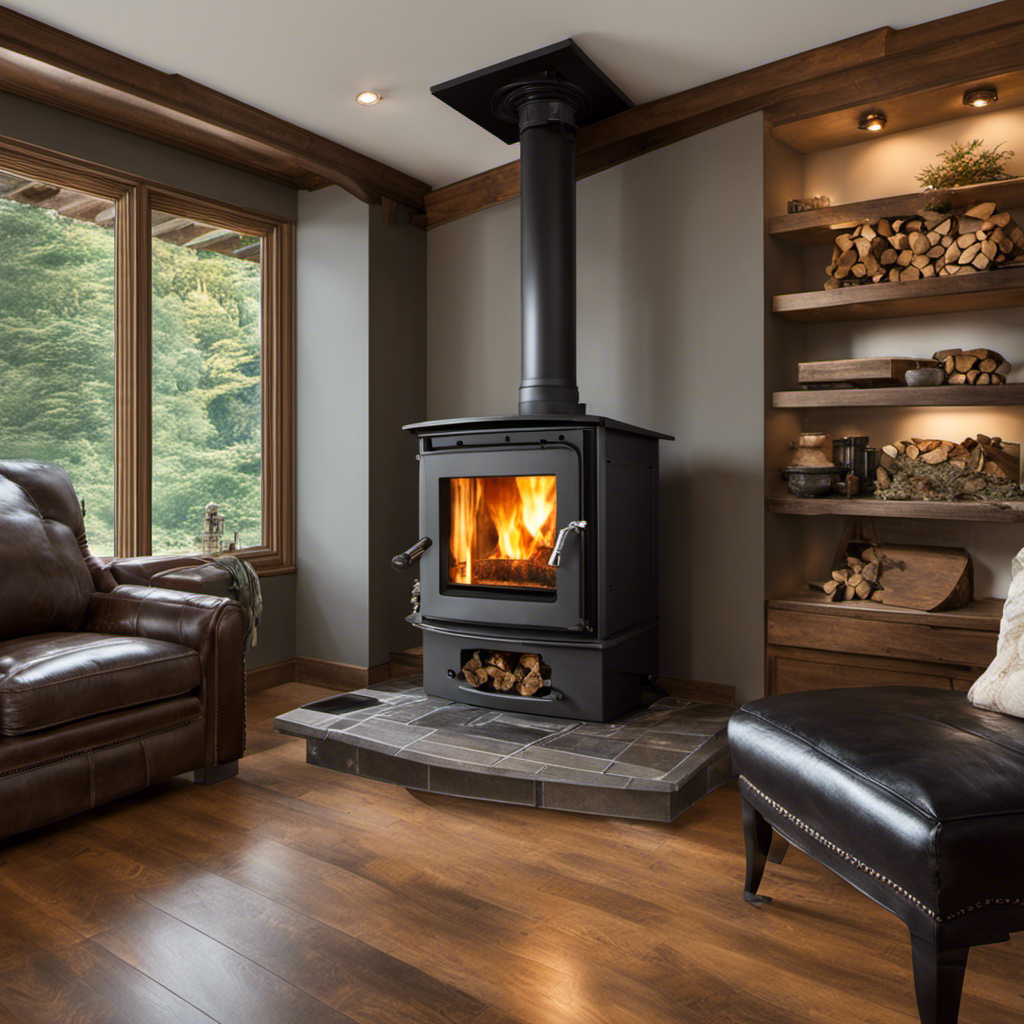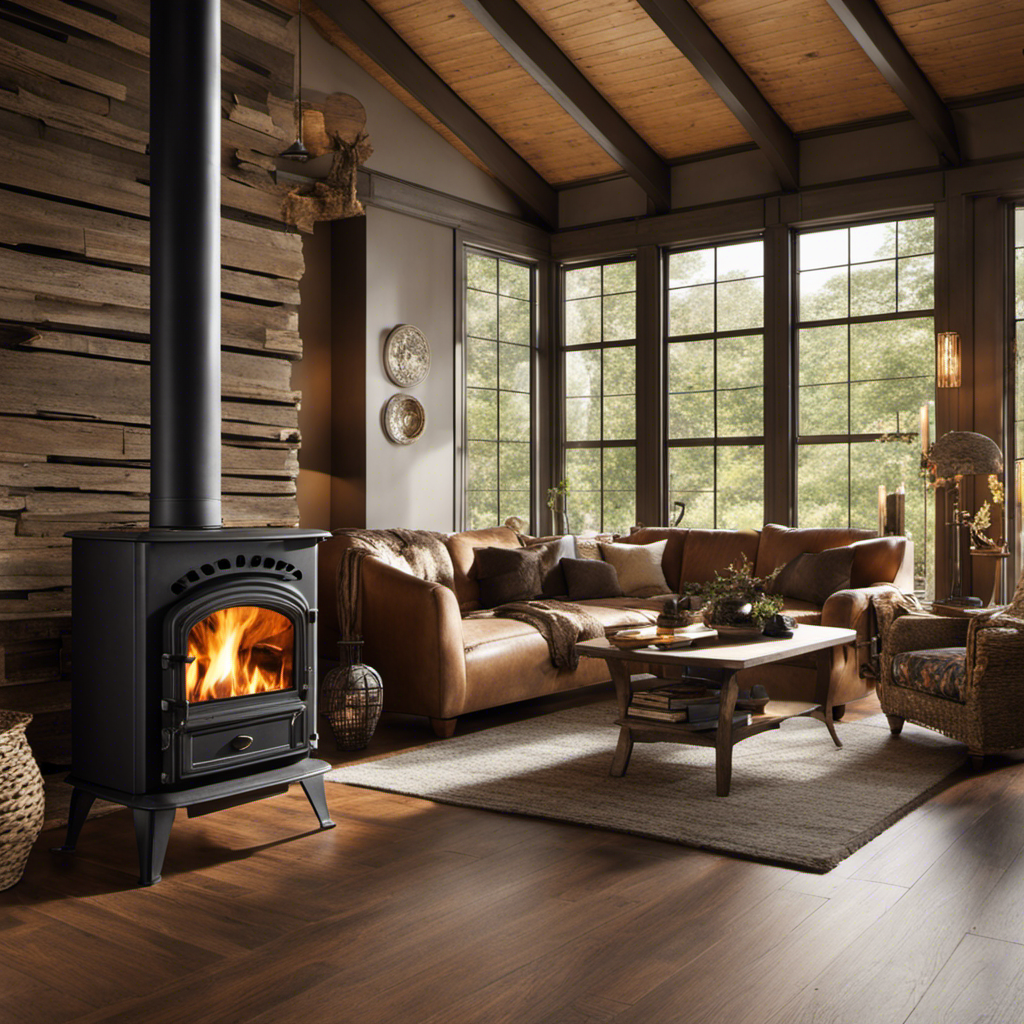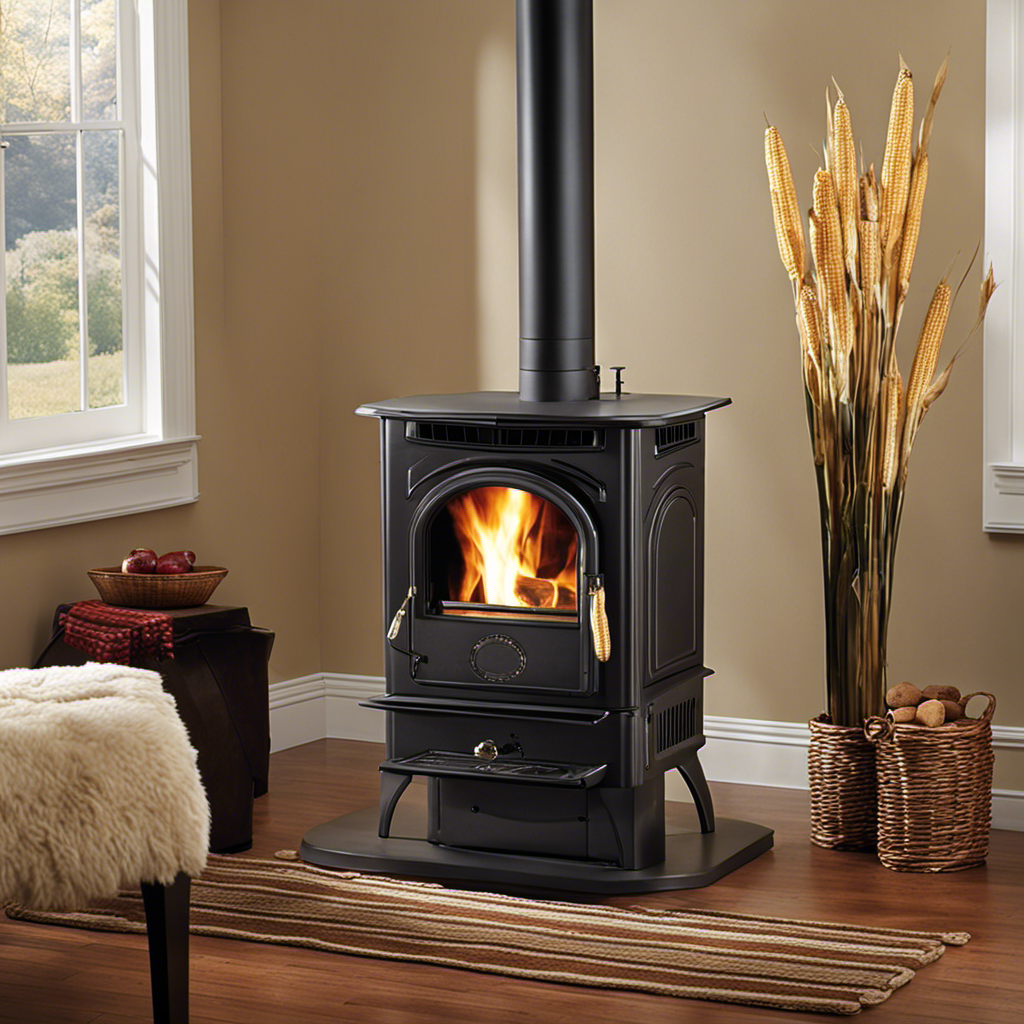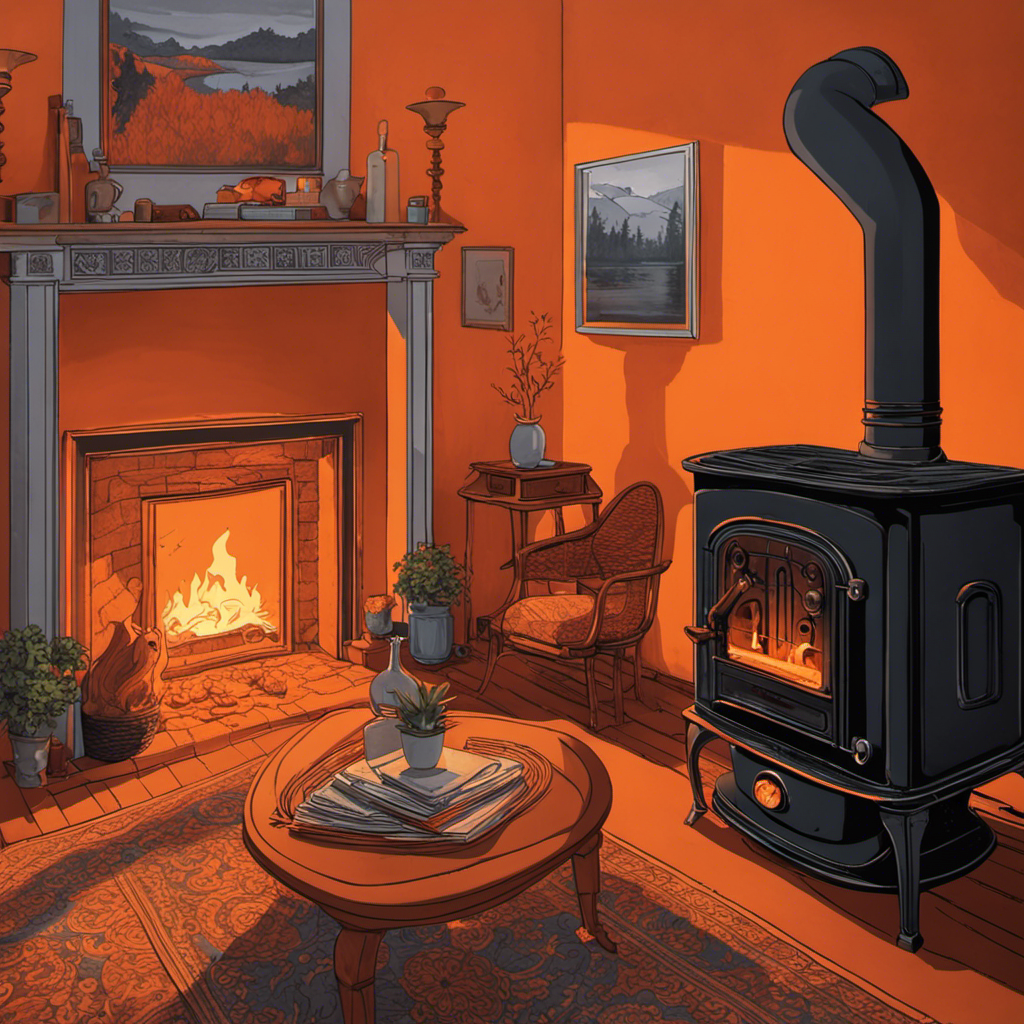As the saying goes, “You become what you burn.” When it comes to selecting the top qualities in wood pellets, have no fear, I’m here to help.
In this article, I’ll delve into the crucial factors that determine the quality of wood pellets. From size and moisture content to ash content and heat output, we’ll explore it all.
Join me as we unravel the secrets behind pellet density, durability, wood type, and certification.
Get ready to make an informed decision for your heating needs.
Key Takeaways
- Wood pellets with a diameter of 6mm to 8mm and a moisture content of 6% to 8% are ideal for optimal performance and efficiency.
- Proper storage of wood pellets includes keeping them in a dry area, away from moisture sources, and in a well-ventilated space to prevent condensation.
- The optimal ash percentage for wood pellets is typically around 1-2%, ensuring efficient combustion and minimal waste.
- Wood type and pellet density play a role in the quality and performance of wood pellets, with hardwood generally producing less ash and higher pellet density contributing to better combustion and heat distribution.
Size
The best wood pellet specs for size are typically those that have a diameter of 6mm to 8mm. This size range ensures optimal performance and efficiency when used in pellet stoves or boilers. The reason behind these specific dimensions lies in the moisture levels and storage methods.
Wood pellets with a diameter of 6mm to 8mm have the perfect balance between surface area and density, allowing for proper combustion and heat output. Additionally, these pellets have a lower moisture content, typically around 10%, which makes them less prone to mold and decay during storage.
Proper storage methods, such as keeping the pellets in a dry and well-ventilated area, further help maintain their quality and prevent moisture absorption.
Now let’s delve into the importance of moisture content in wood pellets.
Moisture Content
When it comes to wood pellets, it’s crucial to understand the importance of moisture levels. Ideal moisture levels for wood pellets typically range between 6% and 8%.
Higher moisture levels can have detrimental effects on the quality and performance of the pellets. This can lead to issues such as reduced heat output and increased emissions.
To ensure proper storage and maintain the desired moisture content, it’s essential to store wood pellets in a dry and well-ventilated area. This area should be kept away from any sources of moisture.
Ideal Moisture Levels
Maintaining ideal moisture levels is crucial for the best wood pellet specifications. Moisture testing is an essential step in pellet quality control.
Wood pellets are typically made from dried sawdust or other wood waste materials. The moisture content of the raw materials plays a significant role in the final product’s quality and efficiency.
If the moisture levels are too high, it can lead to issues such as decreased heat output, increased emissions, and difficulties in igniting the pellets. On the other hand, if the moisture levels are too low, the pellets can become brittle and easily crumble.
Achieving the ideal moisture levels ensures optimal performance and consistency in the wood pellets.
Now, let’s explore the effects of high moisture on the pellet production process.
Effects of High Moisture
To ensure optimal performance and consistency in your wood pellets, it is crucial to avoid high moisture levels. High moisture content can have detrimental effects on combustion efficiency. When wood pellets have excess moisture, they take longer to ignite and produce less heat, resulting in decreased efficiency and lower overall heat output.
In addition, high moisture levels can lead to increased smoke and emissions as the moisture evaporates during combustion. This not only affects the environment but also contributes to the buildup of creosote in your pellet stove or boiler. This buildup requires more frequent maintenance and cleaning.
Therefore, it is crucial to ensure that your wood pellets have a moisture content within the recommended range. This will maximize their combustion efficiency and minimize the negative effects. You can achieve this by using proper storage techniques.
Ensuring Proper Storage
Proper storage techniques are essential for ensuring optimal performance and consistency of your wood pellets. To maintain the quality of your pellets, it is crucial to handle and store them correctly. Improper handling can result in damage to the pellets, affecting their combustion efficiency. Additionally, inadequate storage conditions can lead to the growth of mold, which can be harmful and compromise the quality of the pellets. Here are some key tips for proper storage:
| Proper Handling | Preventing Mold |
|---|---|
| Store pellets in a dry area away from moisture sources. | Keep pellets in a well-ventilated space to prevent condensation. |
| Avoid exposing pellets to direct sunlight or extreme temperatures. | Regularly inspect pellets for any signs of mold or moisture. |
| Stack bags or containers properly to prevent crushing. | Use moisture-resistant packaging or containers to store pellets. |
Ash Content
When it comes to wood pellets, one important factor to consider is the ash content. The optimal ash percentage for wood pellets is typically around 1-2%. This low ash content ensures that the pellets burn efficiently and produce minimal waste.
However, if you’re looking to further reduce the ash content, there are some techniques and additives that can help achieve this goal.
Optimal Ash Percentage
The optimal ash percentage for wood pellets is typically around 1-2%. This low ash content is crucial for optimal combustion and minimizing the environmental impact of burning wood pellets. When wood pellets contain a higher percentage of ash, it can lead to inefficient combustion and increased emissions. To better understand the significance of maintaining a low ash percentage, consider the following table:
| Ash Content | Combustion Efficiency | Environmental Impact |
|---|---|---|
| 1% | High | Low |
| 2% | Moderate | Moderate |
| 4% | Low | High |
As seen in the table, as the ash content increases, the combustion efficiency decreases and the environmental impact worsens. Therefore, it is crucial to strive for an ash percentage of 1-2% in wood pellets. This ensures optimal combustion and reduces the negative environmental effects associated with burning wood pellets. In the next section, we will explore ways to further reduce ash content.
Reducing Ash Content
To reduce ash content in your wood pellets, you can try using higher quality wood and ensuring proper storage conditions. Here are some tips to help you minimize ash residue and improve the overall quality of your wood pellets:
- Use hardwood instead of softwood for your pellets, as hardwood generally produces less ash.
- Avoid using wood with high moisture content, as this can lead to increased ash formation.
- Store your wood pellets in a dry and well-ventilated area to prevent moisture absorption.
- Clean your pellet stove or boiler regularly to remove any ash buildup, as this can affect the combustion efficiency.
- Consider using pellet additives or binders that are specifically designed to reduce ash formation.
Heat Output
You should consider the heat output when choosing the best wood pellet specifications. The heat output of wood pellets is crucial for their burning efficiency and heat distribution. Higher heat output means more warmth and less fuel consumption.
When selecting wood pellets, it is important to check the BTU (British Thermal Unit) rating, which indicates the amount of heat produced per pound of pellets. Look for pellets with a higher BTU rating as they will provide more heat. Additionally, consider the size and moisture content of the pellets, as these factors can also affect heat output.
Pellets with consistent size and low moisture content tend to burn more efficiently, resulting in higher heat output.
Now, let’s move on to another important aspect of wood pellet specifications: pellet density.
Pellet Density
When considering pellet density, it’s important to look for a higher rating to ensure optimal burning efficiency. Pellet density refers to how tightly compacted the wood pellets are. Here are some key points to consider when it comes to pellet density:
- Moisture absorption: Wood pellets with high density have low moisture absorption rates, which means they will produce more heat and burn more efficiently.
- Pellet production process: The density of wood pellets is influenced by the production process. Manufacturers use high-pressure machines to compress the wood fibers, resulting in denser pellets.
- Storage and transportation: Pellets with higher density are less likely to break apart during storage and transportation, ensuring they arrive in good condition.
With higher pellet density, you can expect better burning efficiency, reduced moisture absorption, and improved durability.
This brings us to the next section about pellet durability, where we will explore its importance and factors that contribute to it.
Pellet Durability
With higher pellet density, you can expect improved durability, which is crucial for storage and transportation. The longevity of wood pellets greatly depends on their ability to withstand handling and external elements.
Pellet durability is influenced by various factors, including the manufacturing process. During production, the wood fibers are compressed and bound together, creating a solid and resilient pellet. The manufacturing process plays a significant role in ensuring the pellets maintain their shape and strength. By using high-quality materials and employing advanced techniques, manufacturers can produce pellets with excellent durability. This means that the pellets can withstand rough handling, resist breakage, and maintain their integrity over time.
As we delve into the next section about wood type, it is important to consider how pellet durability can vary depending on the type of wood used.
Wood Type
To determine the ideal wood type for your needs, consider factors such as density, moisture content, and heat output. These factors play a crucial role in wood pellet production and ultimately determine the quality of the pellets.
When it comes to density, hardwoods like oak and hickory are excellent choices as they have a higher density compared to softwoods like pine. Higher density means more energy content per pellet, resulting in increased heat output.
Additionally, moisture content is important to ensure proper combustion and prevent excessive smoke. It is recommended to use wood pellets with a moisture content below 10%.
By carefully selecting the right wood type, you can ensure optimal pellet quality and maximize the efficiency of your heating system.
Speaking of efficiency, let’s now move on to the importance of certification in the wood pellet industry.
Certification
You should look for certification labels when purchasing wood pellets to ensure that they meet industry standards for quality and sustainability. Certification is an important process that evaluates the environmental impact of wood pellet production and ensures that the pellets are made from sustainable sources. Here are five key points to understand about certification:
-
Certification labels indicate that the wood pellets have undergone a rigorous evaluation process to meet specific criteria.
-
The certification process assesses factors such as the origin of the wood, forest management practices, and the carbon footprint of production.
-
Look for certifications like ENplus or Sustainable Biomass Program (SBP) to ensure that the wood pellets are of high quality and sustainably sourced.
-
Certification also helps promote transparency and accountability in the wood pellet industry.
-
By choosing certified wood pellets, you can contribute to reducing deforestation, protecting biodiversity, and mitigating climate change.
Frequently Asked Questions
Are Wood Pellets Suitable for Use in All Types of Wood Pellet Stoves?
Yes, wood pellets are suitable for use in all types of wood pellet stoves. They offer several advantages such as efficient heat output, low emissions, and easy maintenance. Regular cleaning and following manufacturer guidelines are important for optimal performance.
How Long Do Wood Pellets Typically Last When Burned in a Wood Pellet Stove?
Wood pellets typically last for several hours when burned in a wood pellet stove. The burn time can vary depending on factors such as the stove’s settings, pellet quality, and stove efficiency.
Can Wood Pellets Be Used as a Primary Heat Source in a Residential Setting?
Yes, wood pellets can be used as a primary heat source in a residential setting. They have a lower environmental impact compared to fossil fuels and can be cost-effective when compared to other fuel sources for residential heating.
Are Wood Pellets Made From Sustainable Sources?
Wood pellet production has a significant environmental impact. It’s important to choose pellets made from sustainable sources. According to a study, 80% of wood pellets used in the US are produced from forest residues, reducing the need for new tree harvesting.
What Is the Recommended Storage Method for Wood Pellets to Maintain Their Quality?
To maintain the quality of wood pellets, it is recommended to store them in a dry and well-ventilated area. This helps prevent moisture absorption and the formation of mold or mildew, ensuring the pellets remain in optimal condition.
What are the Best Wood Pellets to Use in Wood Pellet Stoves?
When it comes to the best wood pellet stoves, it’s important to use high-quality wood pellets to ensure efficient and clean burning. Look for pellets made from hardwood, with low ash content and a consistent size. Brands like Traeger, CookinPellets, and Green Supreme are known for producing top-tier wood pellets.
Conclusion
In conclusion, when it comes to choosing the best wood pellet specifications, there are several important factors to consider.
The size of the pellet, moisture content, ash content, heat output, pellet density, wood type, and certification all play a crucial role in determining the quality and efficiency of the pellets.
For example, let’s consider a hypothetical case study where two households use different wood pellets. The household using pellets with a higher heat output and lower ash content would experience greater warmth and less maintenance, ultimately saving time and money.
Therefore, it is essential to carefully evaluate these specifications to ensure optimal performance and satisfaction.











